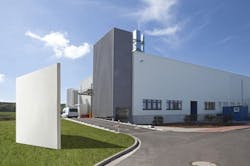The quest for operational excellence increasingly is taking a broader focus both within companies and with partners along the supply chain. Initiatives at Air Products, BASF and Lanxess exemplify the extension of such efforts.
Air Products, Allentown, Pa., promotes operational excellence by setting annual targets for every single plant to maximize value for customers. “These targets include maximizing onstream time, minimizing operating costs, improving productivity, and increasing energy efficiency, as well as certain safety metrics,” explains Yako Wijnands, director of operational excellence.
Part of this involves looking at more specific key performance indicators (KPIs), such as ones for an individual air compressor. “These more specific KPIs vary depending on the type of plant, for example a cryogenic processing plant versus a natural gas reforming plant,” he adds.
To pursue ongoing operational excellence, Air Products also draws upon extensive experience in plant operation and currently monitors and maintains more than 400 industrial gas facilities globally. Foresight and insight about asset performance comes from a patented, web-based, predictive-monitoring and fault-diagnostic platform called ProcessMD. (For more on this platform, see: “Predictive Analytics Capture Heartbeat of Plant.”)
As an example of how this helps to improve overall operational excellence, Wijnands cites the case of a slight increase in valve temperatures at a multi-service reciprocating hydrogen compressor that occurred at a plant just before a planned outage of a sister plant feeding the same pipeline.
“The ProcessMD platform was able to detect this deviation and predict the valve failure, allowing reliability engineers to control and manage the situation by proactively shutting down the compressor and replacing the valves ahead of the sister plant’s planned outage. This avoided machine damage that could have cost in excess of $100,000, as well as significant supply chain costs,” he explains.
Due to increasing market demand, the company also has formalized its operational excellence offering to customers by adding three levels of asset monitoring and control to its existing optimization, troubleshooting and consulting services. The first is a version of ProcessMD designed for customer-owned plants, the second is similar but includes near-real-time-data process monitoring and reporting, while the third adds all the benefits of mentored operations. “So we operate the customer’s industrial gas plant as if it was part of our own fleet,” adds Wijnands (Figure 1).
Figure 1. Company now offers three levels of asset monitoring and control to its customers. Source: Air Products.
Meanwhile, a digital advancement team that was formed in 2017 works closely with the company’s information technology organization, industrial gases businesses and functional units to develop and execute the company’s digital initiatives. Its charter is to help Air Products achieve smarter products, more efficient and agile operations, and simpler, more seamless interactions with customers.
“Digital technologies are transforming the world and providing us with opportunities to accelerate our business capabilities. Digitalization is already enabling us to run our plants more efficiently through technologies such as wireless sensors, cloud computing and analytics. In addition, these technologies help us keep our operating costs competitive and reduce our environmental footprint. We are also joining digital technology with some of our offerings to help our customers optimize their processes as well,” notes Mark Binnig, industrial gases digital transformation manager.
New Initiative
Meanwhile, BASF, Ludwigshafen, Germany, is launching its DrivE strategic operational excellence program at the end of 2018. DrivE is expected to contribute around €1 billion ($1.14 billion) in earnings every year compared with a 2015 baseline and builds on the success of the earlier STEP operational excellence program that has contributed €1.3 billion ($1.5 billion) annually to earnings over its three-year lifespan.
“We constantly work on improving our sites, plants and production processes and are continuing with our restructuring and cost-cutting measures. At the same time, we are increasing our operational excellence through ongoing improvements by harmonizing our business processes worldwide and improving their efficiency,” says Detlef Kratz, senior vice president, corporate technology and operational excellence.
DrivE, which focuses on production, engineering, maintenance, logistics, procurement and administration, aims to lower fixed costs and raise profit margins.
Kratz cites BASF’s polyurethanes production site in Lemförde, Germany, as an example of how strategic operational excellence programs can bring success (Figure 2). The goal there was to increase the loading capacity of inbound traffic by reducing the number of transport types used. The BASF team at the site switched the inbound bulk traffic from road to rail, using a new terminal in Osnabrück, Germany. The outbound bulk traffic from Lemförde now involves only one dedicated carrier. “As well as saving costs, this improves the reaction time of the outbound traffic and requires less investment in infrastructure,” he notes.
Within the programs, improvements are proposed by several groups: a plant’s process engineers and plant managers; an operating division’s technology teams; or in-house corporate consulting teams such as the corporate operational excellence unit. The operational divisions themselves decide which ideas to prioritize.
Figure 2. Operational excellence efforts led to simplified handling of both inbound and outbound shipments at Lemförde site. Source: BASF.
Operational excellence measures come in a broad range — from small plant-owned optimization measures such as adjustments of the running production process, to major modifications of a site’s entire Verbund system [which is what BASF calls its intelligent interlinking of production plants, energy flows and infrastructure].
“The financial benefit per measure varies, too, from several tens of thousands of Euros to ten or more million Euros per year — although on average, it is about €100,000/year. The payback time of these measures is approximately one year or less,” adds Kratz.
BASF believes that digitalization can deliver far more than the gains provided by operational excellence programs because it also creates additional value for customers.
“Sharing data and closer connectivity with key customers and partners offers potential for new offerings and enhanced services,” notes Frithjof Netzer, senior vice president, BASF 4.0.
He cites an example from the company’s gas treatment business. BASF has developed the online platform, OASE connect, that helps customers optimize their operations.
“We enable them to access a digital model of their plant to simulate different operating conditions, based on our experience and calculation models. The results not only lead to a better and deeper understanding among our customers but also improve our model. If the results are applied to the customers’ plants, the operation can be optimized and the yield increased. It’s a digital business model based on increased connectivity,” he explains.
Digitalization also is powering the development of integrated supply chains. For example, BASF uses its digital platform to merge global transportation data with relevant weather data and news feeds from both traditional sources and social media both to predict and react to events that impact the supply chain.
A newly implemented cloud-based application allows the company to exchange important planning data from the supply chain in almost real time with a customer and to simulate various scenarios. “This eliminates long planning cycles and allows us to react to adjustments in the customer’s production planning without delays,” notes Netzer.
On the production side, the same application has allowed the company to combine and analyze data from the steam cracker at Ludwigshafen in ways that it could not before. “Our programmers and process engineers, who are very familiar with the plant, have generated mathematical models which better predict maintenance requirements, thus avoiding downtime and saving costs,” he concludes.
(For more on BASF’s digitalization efforts, see “Digitilization Drives Development.”)
Manufacturing Excellence
Lanxess, Pittsburgh, Pa., is using its manufacturing excellence (MEx) initiative to hone operational excellence. The effort has two main targets: operating plants at optimal cost and maximum productivity. To achieve this, MEx teams work with plant management to analyze specific issues including production and logistics, processes and energy, and plant maintenance.
The maintenance and production efforts aim at standardizing work processes and applying best practices. For processes and energy, the focus is reducing raw material and energy consumption.
“Manufacturing excellence is a means of gaining competitiveness. The MEx initiative continuously and sustainably positions Lanxess within the best-in-class in the framework of a continuous improvement process,” says president and CEO Antonis Papadourakis.
Running since 2014, the initiative has generated savings in every targeted area and recently has been extended to some of the sites of Chemtura, which Lanxess acquired in 2016.
“The excellence program is another tool in our efforts to successfully integrate our new acquisition. This initiative complements very well our ongoing strategy of taking leading positions in mid-sized, profitable specialty chemicals markets with a strong focus on the growth region of North America,” Papadourakis explains.
At the same time, the company, which very much sees digitalization as a topic of process improvement and organizational development, is linking it to another ongoing effort — a commercial and supply chain excellence initiative. This is a global initiative, led from world headquarters in Cologne, Germany, aimed at running integrated processes with the same tools and systems across all company sales, marketing, production, procurement and supply chain activities.
“We see digitalization very much as a topic of process improvement and organizational development. As process standardization is an essential prerequisite for digitalization, all activities initiated by the commercial and supply chain excellence initiative will be continued and expanded into the process landscape of Lanxess. This will cover the whole value chain and address changing requirements and new opportunities of suppliers and customers alike,” concludes Papadourakis.
Doing More With Data
Most manufacturers today are awash with data but don’t take full advantage of these inputs. Chemical companies typically use something under 10% of their available data, notes Martin Valek, industry director, chemicals & pharma, GE Digital, Frankfurt, Germany.
“Chemical customers tell us this and it’s probably a consistent figure across much of industry generally. For a start, people tend not to want to share information — and even having access to the data is still a long way from having a fully automated data processing ability. For this, you really want to be in the cloud and then build the application around it.”
Designed to get information from the data and then deliver it to the right people in the right place, the Predix platform is GE Digital’s answer to this. (For more on other efforts related to predictive analytics and doing more with data, see: “Finding What’s Hiding Gets Easier.”)
“Chemical companies approach us to see where Predix can help with existing advanced data analytics, or to help build and maintain their own home-grown data analytics and sophisticated models that they developed in siloed, often non-industrial tools,” he adds.
Marrying machine data with data analytics and physics, such as computer-aided-design models, allows building a digital twin on the platform that is accessible to everybody along the entire supply chain.
“This digital transformation changes the value chain, especially between producer and end-customer. Chemical manufacturers look for ways to get much closer to the consumer and simply bypass the distribution channels. Performance coating companies such as BASF, AkzoNobel and Covestro are already doing this. The trick here is to enable companies to create shortcuts within the value chain. However, to do that you need to be digital and to build digital interfaces to customers and suppliers who, in the meantime, also become digitally viable,” explains Valek.
To help with this move, GE Digital in June launched ServiceMax and Avitas Systems. They are designed to accelerate onto one platform the integration of technologies involved in field management, asset performance management, advanced robotics, data analytics and artificial intelligence.
Valek has been involved in a couple of pilot projects using them in upstream chemical processing: “Chemical companies often already have condition monitoring in place to improve machine or plant reliability. Only companies with mature digital transformation roadmaps think how to use machine health data to build sophisticated asset strategies which require full data integration across various spreadsheets, EAM [enterprise asset management] and ERP [enterprise resource planning] tools. And only a few companies go even further and are piloting full integration of the next-generation technology as AI [artificial intelligence], augmented reality or robotics-based inspection. The dream for chemical engineers is to apply these technologies not as point solutions but linked back to the process. Together, these new launches are about how we create systems as we follow the value chain. Then if it all sits on one platform, it’s very much easier to get the data to the right place at the right time.”
Once all the data are truly available, creating a powerful digital plan for the future will be possible. “Note that this will require not just automation engineers, but the entire engineering population will need to have new skills; data analytics, artificial intelligence and augmented reality content will form our jobs, while working with digital twins will replace the usual cut and try approach with simulations in the virtual cyber space,” he concludes.





